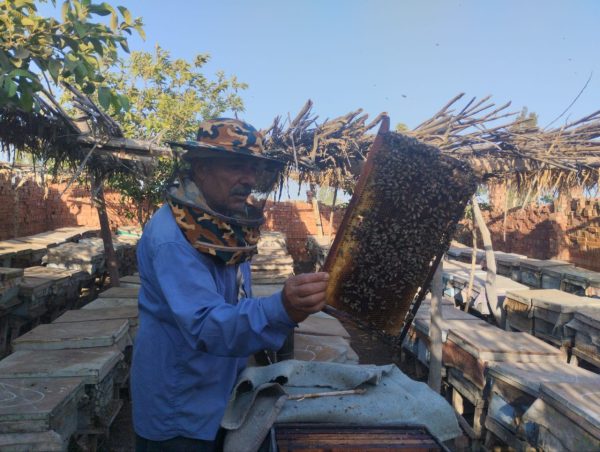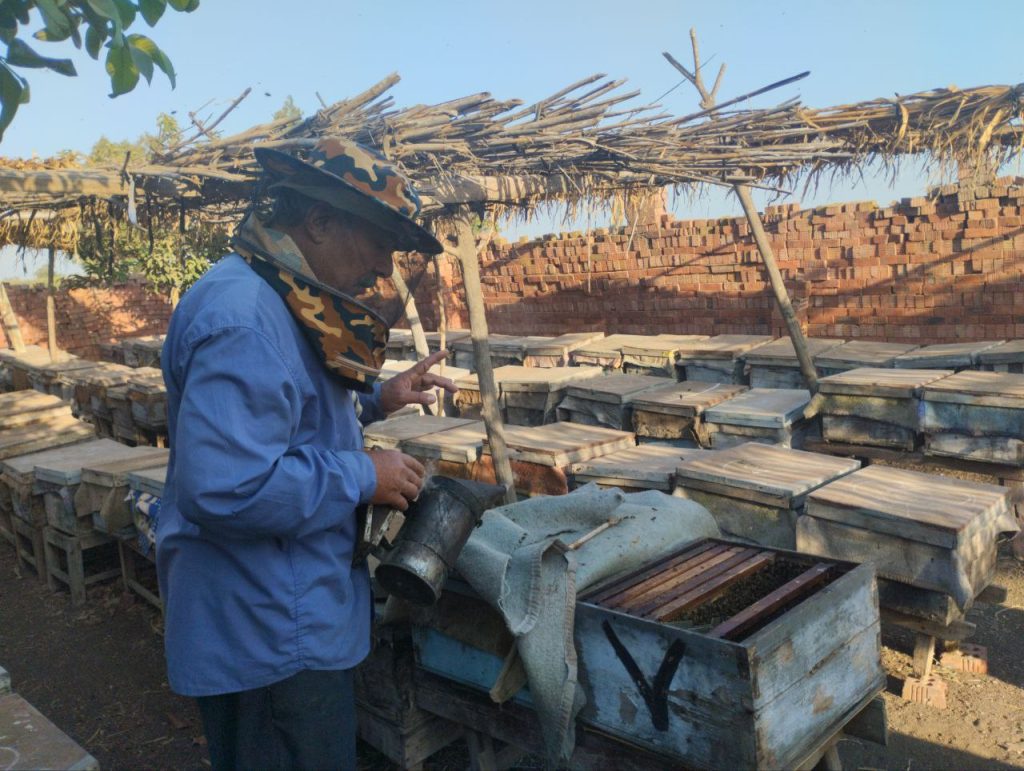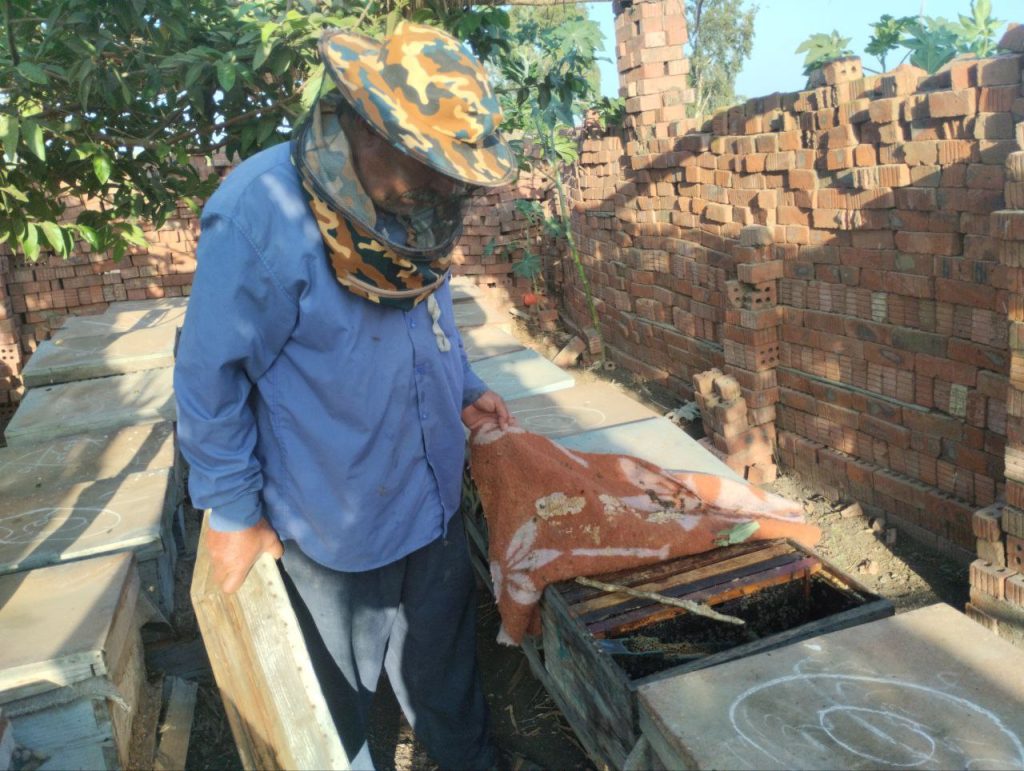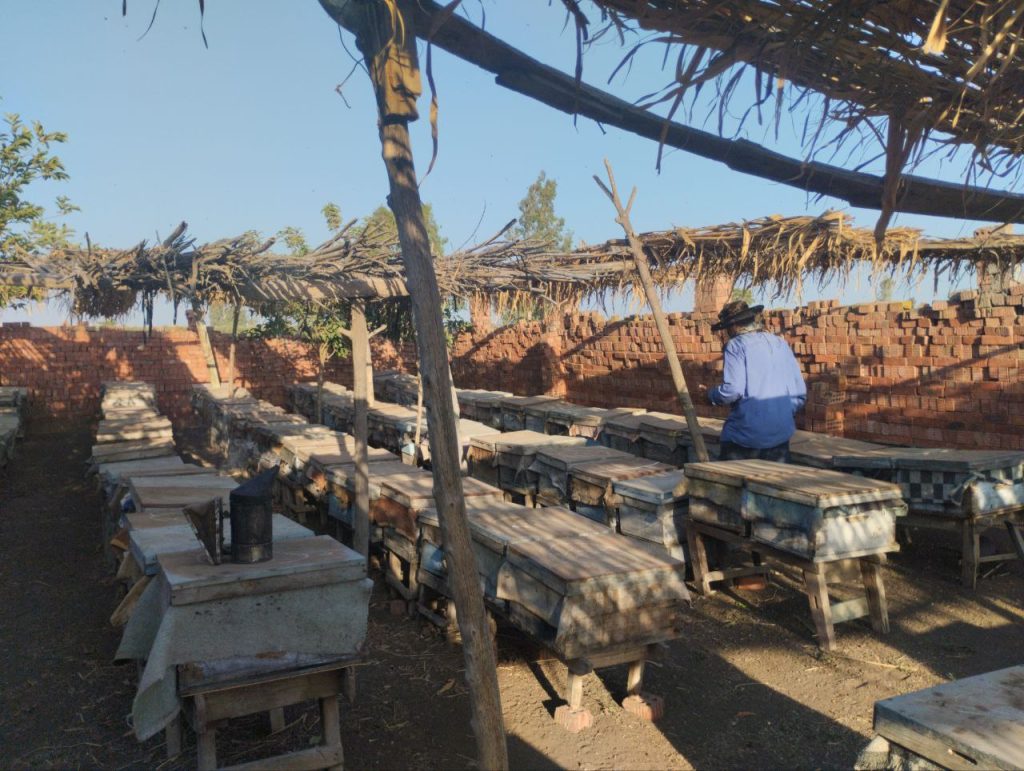On the outskirts of the city of Al-Sayyid Al-Badawi, nestled in the heart of the authentic countryside, lies the village of Hessa Shabshir, part of the Tanta district in the Gharbia governorate. The apiaries are quiet, and the houses are clustered between the fields and along the roadsides, pulsating with a life different from that of other Egyptian villages, as they produce 70% of the country’s honey.
Life in Shabshir is not measured by the number of inhabitants, but by the number and growth of beehives. Although many beekeepers have abandoned the profession in recent years and turned to travel, the village has a different flavor. In this month of every year, the atmosphere flourishes in preparation for the sorting season, whether by hand or using modern tools.
Honey harvest season
I set off on a long journey through the village and saw the doors of the hives open everywhere. I believed the beekeepers when they said that this year’s harvest was abundant despite the scarcity of clover. I was convinced that this village had a different spirit, attracting thousands of workers to taste natural, unadulterated honey.
When I tasted it, it had a pleasant effect on me and healed my constant questions about the possibility of living there. My father was a beekeeper, and since I was a child, I had been afraid to go near our apiary.
I remember the day of sorting well and the precautions taken by calling experts from the village of Hessa Shabshir. I also remember him telling my mother to honor the guests because they were from Hessa, the most famous village in the west at the time for honey. Now it is famous throughout the country and perhaps the Arab world.
The guardian of the hive
He resembles bees in his silence and work, circling around houses selling his bees’ honey at this time of year. He moves with lightness and joy, resembling the bees in his patience with people to pay for the honey and wax, just as the bees are patient with their nectar. This is the least that can be said about Uncle Emad when he talks about his love for his profession.
In one of the apiaries in the village of Hessa Shabshir, Uncle Emad accompanies his bees, checking on their nectar and their work. He tells Bab Masr Bahri that he inherited his love for the profession from his grandfather and started working in it when he was 20 years old. Now 60, he took up the profession again with the encouragement of his friend Ahmed. Together, they opened their own apiary, where their hybrid bees produce honey with a distinctive flavor.
Jamil adds, “I only had three wooden boxes, which my father handed to me with his own hands, telling me to take good care of them. Although he did not work in the profession, he loved the sorting season and God’s bounty. Since then, I have raised every hive, living with its peaceful spirit and learning a lot from it.”
Beehives in the village of Hassa Shabshir
With a bright face, Emad recalls his memories with the bees and the system he learned from observing his hives. The village has many beekeepers, but his hives take on another meaning when he looks at them every day. He works in education and draws stories from the bees, reflecting them as values for his students. He remembers the village from his childhood, its alleys and apiaries, and the sweetness of its people, like the sweetness of their honey.
Jamil laments the state of the village and the beekeeping profession. He regrets the gradual disappearance of the profession, after the entire village used to work as a beehive. He emphasizes that young people have turned to traveling abroad and higher education instead of benefiting the village, developing it, and preserving its heritage. He senses the slow change taking place in his shop and laments it. However, he believes that even if the bees change, his love and patience for them will not.
A close-knit village
“Seven years ago, the village of Hessa Shabshir was ranked first in the Gharbia governorate as the village with no unemployed people. Everyone works in the beehives and earns a wage, even in honey production. We care for the hives with the same spirit, but the young people don’t help.” These were the first words of Hajj Fouad Badran, a member of the Wadi al-Nil Honey Bee Breeding Association, to Bab al-Masr – Bahri.
He explained that the secret lies in the return of young people from Iraq. It was necessary to find a way to help them earn money, and so they turned to beekeeping. He emphasized that what distinguishes this village from other Egyptian villages that engage in honey bee breeding is that it has succeeded in exporting honey products in addition to honey itself. The village had workshops for manufacturing wax and beekeeping clothing, as well as factories for bottling honey and exporting it abroad.
The disappearance of the honey harvest
Unlike Amad, Hajj Badran is not afraid that the profession will disappear from the village. Rather, he fears that the memory of the village will be lost in the younger generations, because even if they work, they do so without passion. He fears that honey will disappear from the homes of the village’s old beekeepers who have retired from the profession, and that the history of the hives will be lost.
Hajj Fouad owns many hives in the mountains, in the lake and in Kfar al-Sheikh. But he no longer travels as much as he used to. He insists that he stays with the villagers during the sorting season and does not sort himself, supervising his hives from afar. He encourages his children not to abandon the profession, to always remember it, and to travel and spread the word about honey and its products.
Badran concluded by saying, “What binds the village together is honey bees. If we stop raising them, life in the village will come to a halt. The profession began in the village in the 1950s. Shabshir honey became known throughout Egypt, and the village’s children feed on it. I always say that those who know Shabshir honey know the ten good deeds and the meaning of life and regular work. Everyone in the village understands this meaning very well.”
Types of honey in Shabshir
Musa al-Rifai is proud to be a descendant of four generations of beekeepers in his village. He expresses his gratitude and thanks to God for spending his life among the apiaries to Bab Masr – Bahri.
He inherited patience and wisdom from them, and he is grateful that he can see his livelihood before his eyes every year, even if he works harder and the yield is low. It is enough for him to witness the drops of honey falling from the hives with love and satisfaction at the Creator’s division.
Al-Rifai loves the types of honey produced by the queen bees in the village. He loves sidr, clover, and citrus honey, and he loves sorting honey every June and July. He loves traveling to the mountains afterwards to live another story with sidr honey. He insists that the Caucasian queen is the best type of queen in his apiary, along with the hybrid and Cornish queens.
He points to the beginning of the profession in the village in the 1950s. A man named Hajj Mahjoub brought his hives from Qena and came to the village to settle there. He heard that he was impressed by the fresh air and the growth of flowers there, and from that moment on, bees became an integral part of the details of the houses and stories.
Where is the village headed?
After my tour of the village, I noticed that most of the houses live on seasonal migration with their beehives. In winter, they head south to warmer places and return to the village to harvest white honey. The village has its own dialect, which is different from that of the westerners. It is enthusiastic, patient, cheerful, and passionate about everything related to honey.
In Shabshir, you will find a rare blend of cultural and agricultural diversity, combining heritage, popular economy, and modernity. They do not just produce honey. They focus on ensuring that its sweet scent reaches every corner of the village, and the women of the village have preserved the skill of making wax with their hands. Although prices have increased, with a kilo of honey now costing 200 pounds, they always try to maintain the quality of the honey and ignore those who cheat.
The problem of marketing honey
Life there is not without its obstacles, but they always try to overcome them, especially since marketing honey has become a problem. It is limited to neighboring villages and old customers, according to Ali, one of the young men working in the apiary. In addition, the vibrations that the bees receive from exposure to electricity poles in the fields affect the quality of their production, and the development that the village undergoes every day becomes a burden on them. However, their steadfastness in their principles of not cheating with honey is what distinguishes the village to this day.
To the rhythm of the bees’ wings, the village continues to struggle until its last breath, as its people say. It retains its charm despite the challenges, and its people learn patience, regularity, wisdom, hard work, and organization from their apiaries. Life there passes with a lightness that passersby do not notice, but the fruit is the greatest medicine for the heart and body: honey. This is a village that has taught its people that everything beautiful begins with the hive.









Hi, this is a comment.
To get started with moderating, editing, and deleting comments, please visit the Comments screen in the dashboard.